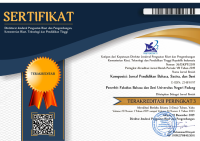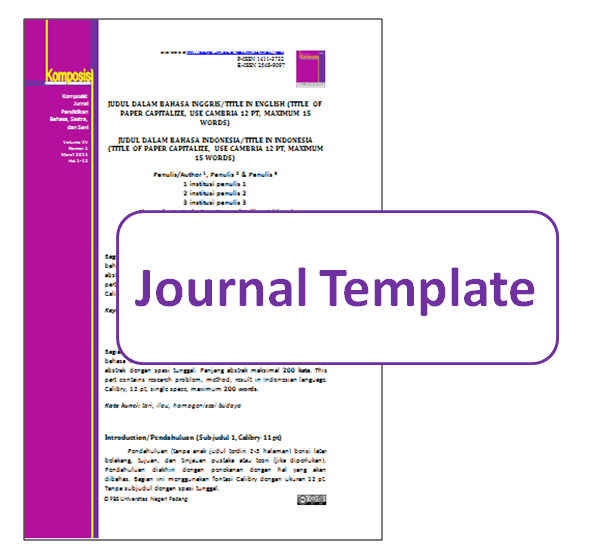The Feasibility of West Sumatra Folklore as Indonesian Literature Teaching Material in High School
Yulia Fitrina, Yenni Hayati, M. Hum., Muhardis Muhardis
Abstract
Cultural and social values that exist in Indonesia need to be taught, considering that current technological advances have an impact on the reluctance of students to learn about cultural and social values. Therefore, Indonesian language and literature teachers should be able to present learning that is integrated with cultural and social values in Indonesia. The reading texts of folklore in Indonesian teaching materials generally come from various regions in Indonesia. Judging from various folklore documentation, West Sumatra is actually rich in folklore. Each region in West Sumatra has interesting folklore and contains educational values. Of course, to be used as teaching material, there needs to be a feasibility test on these folk tales. The origin of the selected folklore texts also varies, namely the Legend of Sabai Nan Aluih from Luhak Tanah Datar, the Legend of the Origin of Lake Maninjau from Luhak Agam, the Legend of Tuanku Taram from Luhak 50 Kota, the Legend of Batu Puti from Sijunjung and Lebai Malang from the Andalas area. The respondents of this study are two teachers of Indonesian Language and Literature at the six sample schools, namely SMAN 1 Banuhampu and SMAN 2 Tilatang Kamang from Agam Regency, SMAN 1 Pariangan and SMAN 1 Batipuah from Tanah Datar Regency, and SMAN 1 Suliki and SMAN 1 Harau from District 50 Kota. The teachers were given an instrument in the form of a questionnaire consisting of five questions for each folklore. As a result, there are five indicators to determine the feasibility of West Sumatra folklore used as teaching materials, namely the language of this folklore is easy to understand, appreciative, educates characters, develops imagination, interesting, and gets a "Good" category rating.Keyword: dance, ilau, cultural homogenization
Keywords
folklore; west sumatra; teaching materials; feasibility test
References
Abou-Zeid, A., Bushraa, A., & Ezzat, M. (2007). Overview of Feasibility Study Procedures for Public Construction Projects in Arab Countries. Journal of King Abdulaziz University-Engineering Sciences, 18. https://doi.org/10.4197/Eng.18-1.2
Anafiah, S. (2015). Pemanfaatan Cerita Rakyat sebagai Alternatif Bahan Bacaan bagi Anak. Trihayu: Jurnal Pendidikan Ke-SD-An, 1(2), 128–133.
Borg, W. R., & Gall, M. D. (1989). Educational research An introduction (5th ed.). Longman.
Dananjaya, J. (2022). Folklor Indonesia ilmu gosip, dongeng, dan lain-lain (6th ed.). Jakarta Pustaka Utama Grafiti.
Dick, W., & Carrey, L. (1985). The Systematic Design Instruction Second edition. Scott., Foreman and Company.
Djamarah. (2002). Strategi Belajar Mengajar. Rineka Cipta.
Kuswara, & Ena, S. (2021). Apresiasi Cerita Rakyat sebagai Upaya Memperkuat Karakter Siswa dalam Menghadapi Revolusi Industri 4.0. Jurnal Basicedu, Vol 5(1). https://doi.org/https://doi.org/10.31004/basicedu.v5i1.678
Laila, N. A., & Ibrahim, N. (2021). STRUKTUR DAN KAIDAH KEBAHASAAN CERITA RAKYAT DALAM BSE BAHASA INDONESIA KELAS X SMA TAHUN PELAJARAN 2020/2021. Jurnal Pendidikan Bahasa Dan Sastra Indonesia, Vol. 11(4). https://doi.org/https://doi.org/10.23887/jjpbs.v11i4.37179
Masanja, N. (2020). A PRACTICAL GUIDE TO WRITING A FEASIBILITY STUDY.
Mulyatiningsih, E. (2012). Riset Terapan Bidang Pendidkian dan Teknik. UNY Press.
Sugiyono. (2011). Metode Penelitian Kuantitatif Kualitatif dan R&D. Alfabeta.
Sumayana, Y. (2017). Pembelajaran Sastra di Sekolah Dasar Berbasis Kearifan Lokal (Cerita Rakyat). Mimbar Sekolah [Online], 4(21), 8. http://ejournal.upi.edu/index.php/mimbar/ article/download/5050/pdf
Thompson, C. (2009). Descriptive Data Analysis. Air Medical Journal, 28, 56–59. https://doi.org/10.1016/j.amj.2008.12.001
DOI:
https://doi.org/10.24036/komposisi.v23i2.117316
Refbacks
There are currently no refbacks.
Copyright (c) 2022 Komposisi: Jurnal Pendidikan Bahasa, Sastra, dan Seni
This work is licensed under a
Creative Commons Attribution-NonCommercial 4.0 International License .
Komposisi: Jurnal Pendidikan Bahasa, Sastra, dan Seni , a peer-reviewed online journal in languages, literature, and arts education.
Printed ISSN 1411-3732 , Online ISSN 2548-9097 .
Currently, Komposisi: Jurnal Pendidikan Bahasa, Sastra, dan Seni is indexed by: View My Stats
Visitors since February 2017:
Statcounter <div class="statcounter"><a title="web analytics" href="http://statcounter.com/" target="_blank"><img class="statcounter" src="//c.statcounter.com/11239717/0/d5796c6b/0/" alt="web analytics"></a></div> View My Stats
Published by:
Universitas Negeri Padang (UNP) Address: Faculty of Languages and Arts (FBS) Universitas Negeri Padang. Jl Prof. Dr. Hamka Air Tawar Barat, Padang - West Sumatera -Indonesia Telp/Fax. +62751 7053363 Home page: http://ejournal.unp.ac.id/index.php/komposisi | e-mail:komposisi.fbsunp @ fbs.unp.ac.id | cc: havid_a @ fbs.unp.ac.id
https://m.certified-lighting.com/
Server Luar
slot88
King Wood Car Care slot gacor
scam
situs toto
bandar togel
bandar togel
Slot Gacor Hari ini
situs toto
situs toto
toto togel
togel online
topup murah
harapan777
AMDBET
toto togel
slot88
login bayar4d
macau303
slot resmi apk slot online Slot Maxwin
situs toto
sakti55
situs toto felix168
nextogel
NEXTOGEL
NEXTOGEL
NEXTOGEL
NEXTOGEL
NEXTOGEL
NEXTOGEL
NEXTOGEL
NEXTOGEL
NEXTOGEL
NEXTOGEL
NEXTOGEL
NEXTOGEL
NEXTOGEL
NEXTOGEL
NEXTOGEL
NEXTOGEL
NEXTOGEL
NEXTOGEL
NEXTOGEL
NEXTOGEL
NEXTOGEL
NEXTOGEL
NEXTOGEL
NEXTOGEL
NEXTOGEL
NEXTOGEL
NEXTOGEL
NEXTOGEL
NEXTOGEL
NEXTOGEL
NEXTOGEL
JEPETOGEL
JEPETOGEL
JEPETOGEL
JEPETOGEL
KIM369
KIM369
KIM369
KIM369
KIM369
KIM369
KIM369
KIM369
KIM369
KIM369
situs toto toto slot kuntogel
situs toto toto slot sendok88
togel online toto slot https://www.eaglehighplantations.id/
toto macau
slot gacor slot gacor
batak5d toto slot Slot88 www.onscripture.com
slot online
situs toto
situs gacor bandar togel resmi toto togel https://montreallawfirm.com
wild west gold sering pecah
Toto 4D
slot88
toto macau
Situs Toto
Situs Toto
https://mercubuana.org/
Toto 4d
toto 4d
Toto 4D
toto 4d
info rtp akurat malam ini
Wanita Subang Beli mobil dari Nolimit city
rahasia Cuan Aztech Gems
Gatot kaca Buat TKW Jadi jutawan
Rahasia sukses bermain Mahjing wins
harapan princess starlight
Harapan sweet bonanza
taktik gates of olympus xmas
dukungan gates olympus
rahasia sukses bermain mahjong ways
Situs togel
slot gacor 2025
luxury89
Sulebet
sulebet
oja89
basic4d
situs toto togel online
vipbet888
momo128 login
https://garudafood.org/
jpmania mesin128
mesin128
mesin128
oja89
slot gacor
jumat4d slot login
https://pintu-pro.id/
slot gacor
Buat yang suka cari link slot gacor hoki69 maxwin tiap hari, ini tempat yang paling sering gue datengin.
choicehomecontractors.com
sarangslot
slot 4d gacor hari ini
Toto 4D
https://up2m.pkr.ac.id/jepangbet/
slot
simpatitogel
slot gacor hari ini
slot gacor
slot
https://unesa.id/
xl bola
slot gacor
vega168
Togel 4D
slot gacor
bandar togel
slot777
sbobet
https://sidangmakmur.desa.id/sida/
pin4d
situs toto situs toto SON4D : KONSEP SLOT TYPE MODIFIKASI MOTOR GAYA THAILAND TERBARU ARI69 situs slot gacor slot777
toto slot
slot depo 10k
slot gacor 777 slot Slot Demo
slot gacor
https://ebelinshop.com/
pin4d
ajo89 situs toto
<a style="visib












